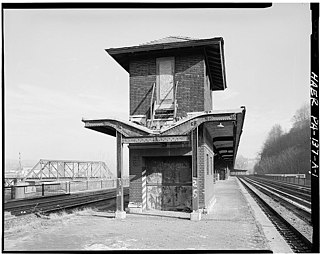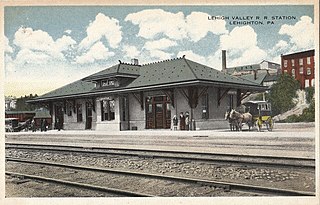
Carbon County is a county in the Commonwealth of Pennsylvania. It is located in Northeastern Pennsylvania. As of the 2020 census, the population was 64,749. The county is also part of Pennsylvania's Coal Region and Northeastern Pennsylvania.

Jim Thorpe is a borough and the county seat of Carbon County in the U.S. state of Pennsylvania. It is part of Northeastern Pennsylvania. It is historically known as the burial site of Native American sports legend Jim Thorpe.
The Lehigh Valley Railroad was a railroad built in the Northeastern United States to haul anthracite coal from the Coal Region in Pennsylvania. The railroad was authorized on April 21, 1846, for freight and transportation of passengers, goods, wares, merchandise, and minerals in Pennsylvania and the railroad was incorporated and established on September 20, 1847, as the Delaware, Lehigh, Schuylkill and Susquehanna Railroad Company.

The Reading Blue Mountain and Northern Railroad, sometimes shortened to Reading and Northern Railroad, is a regional railroad in eastern Pennsylvania. Its headquarters is in Port Clinton. The RBMN provides freight service on 400 miles (640 km) of track. Its mainline consists of the Reading Division between Reading and Packerton and the Lehigh Division between Lehighton and Dupont. Its main freight cargo is anthracite coal.

Lehigh Gorge State Park is a 4,548 acres (1,841 ha) Pennsylvania state park in Luzerne and Carbon Counties, Pennsylvania. The park encompasses a gorge, which stretches along the Lehigh River from a U.S. Army Corps of Engineers flood control dam in Luzerne County to Jim Thorpe in Carbon County. The primary recreational activity at Lehigh Gorge State Park is white water rafting.
The Lehigh Coal and Navigation Company (LCAN) (1988–2010) was a modern-day anthracite coal mining company headquartered in Pottsville, Pennsylvania. It acquired many properties and relaunched the Lehigh Coal Companies brand in 1988. The LCAN ran strip mining operations in the Panther Creek Valley east of Lansford, Pennsylvania along U.S. Route 209 with vast properties dominating the coal areas of Tamaqua, Coaldale, and Lansford.

Duryea Yard is a railroad yard in the Wyoming Valley region of Northeastern Pennsylvania currently operated by the Reading Blue Mountain and Northern Railroad. Originally constructed in 1870 by Lehigh Valley Railroad as a turn-around and staging hub for coal transport from the Coal Region to Eastern big-city markets, the yard remains a hub for the energy extraction industry today.

Robert Heysham Sayre was vice president and chief engineer of the Lehigh Valley Railroad. He was also vice president and general manager of Bethlehem Iron Company, the corporate precursor to Bethlehem Steel. The borough of Sayre, Pennsylvania and the small city of Sayre, Oklahoma were named in his honor.

Asa Lansford Foster was a Pennsylvanian geologist, merchant, and coal mine owner. He was also a geologist, mining engineer, and publisher and was one of the pioneers of the anthracite industry. He was a native of Massachusetts but immigrated to Pennsylvania in 1818. Foster married Louisa Trott Chapman.
The Lehigh and Susquehanna Railroad is a defunct railroad that operated in eastern Pennsylvania during the 19th and 20th centuries. The company was a subsidiary of the Lehigh Coal & Navigation Company (LC&N). For much of its lifetime, however, it was leased by the Central Railroad of New Jersey.
East Mauch Chunk is a former independent borough in Carbon County, Pennsylvania, United States. Located along the east bank of the Lehigh River on the opposite bank from the town business district, it was part of Northeastern Pennsylvania.

Mountain Top yard or Penobscot yard is a rail yard in Mountain Top, Pennsylvania. It was built by the Lehigh Coal & Navigation Company (LC&N) in response to an 1837 bill authorizing a right of way and was established by 1840, at least as a construction camp for the Ashley Planes, in support of the construction of the Lehigh and Susquehanna Railroad trackage and operations to join the northern Anthracite Coal Region from barge loading docks along the Susquehanna in Pittston, in the Wyoming Valley, with the Lehigh Canal.

The Lehigh Line is a railroad line in Central New Jersey, Northeastern Pennsylvania, and the Lehigh Valley region of eastern Pennsylvania. It is owned and operated by the Norfolk Southern Railway. The line runs west from the vicinity of the Port of New York and New Jersey in Manville, New Jersey via Conrail's Lehigh Line to the southern end of Wyoming Valley's Coal Region in Lehigh Township, Pennsylvania.

Easton is a defunct train station in Easton, Pennsylvania. It was originally built by the Lehigh Valley Railroad. As of 2017, the structure still exists and was blighted for at least 20 years, since its closing in the 1970s. The city of Easton obtained permission from Norfolk Southern Railway to clean up the property. The location only recently became a focal point for the city with the opening of Interstate 78 in the 1990s.

Lausanne, alternately named Lausanne Landing of the 1790s–1820s was a small settlement at the mouth of Nesquehoning Creek on the Lehigh River in marshy delta-like flood plain. Some historic references will mention the presence of a 'Landing Tavern' as the entirety of the town. Lausanne township was originally organized out of dense wilderness along an ancient Amerindian Trail, the "Warriors' Path" an important regional route as it connected the Susquehanna River settlements of the lower Wyoming Valley to those around Philadelphia.

Allentown was a train station in Allentown, Pennsylvania. It was opened by the Lehigh Valley Railroad in 1890 and closed in 1961. The building was demolished in 1972. The station was located one block west of the Central Railroad of New Jersey's Allentown station.
Slatington station was a Lehigh Valley Railroad station in Slatington, Pennsylvania, located on the Lehigh Valley main line. The station also served the Lehigh and New England Railroad; the Reading Company at one time had an adjacent station. The Central Railroad of New Jersey had an unconnected station across the Lehigh River in Walnutport, Pennsylvania.

Laurys station, also known as Laury's station, was a Lehigh Valley Railroad station in Laurys Station, Pennsylvania. Both the station and locality drew their name from David Laury, a local notable who established a hotel on the site in 1832 and later served as postmaster.

Catasauqua station was a Lehigh Valley Railroad station in Catasauqua, Pennsylvania. It was located on the Lehigh Valley main line.

Lehighton station was a Lehigh Valley Railroad station that was located in Lehighton, Pennsylvania, USA. It was part of the Lehigh Valley main line, and was also the eastern terminus for Hazleton Branch passenger trains, although the branch diverged at Penn Haven Junction, north of Jim Thorpe.















